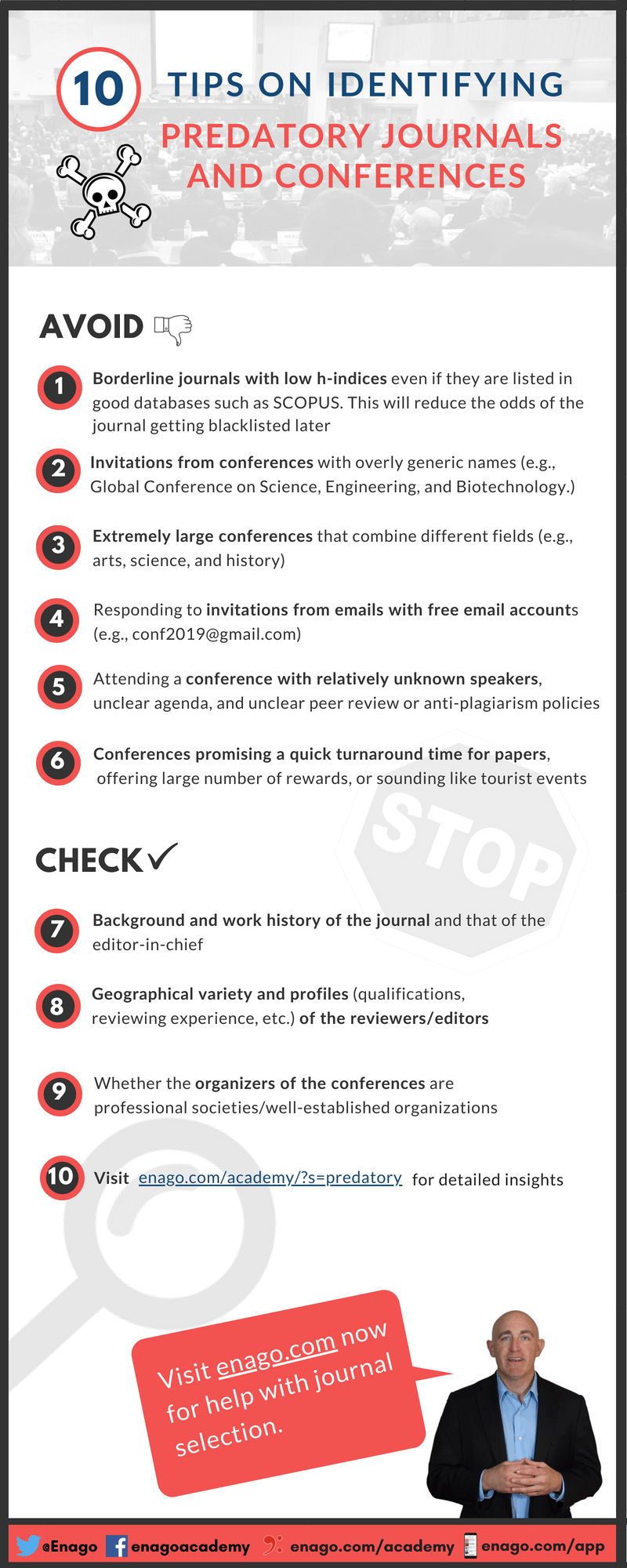Identifying Predatory Journals Using Evidence-based Characteristics

Academic researchers are under pressure to publish their research in order to advance at their educational institution, solicit funding for their research or programs, or even to maintain their employment. Publishers, such as BioMed Central, who provide open-access publishing through its nearly 300 journals, are dedicated to providing free access to articles so as to promote academic research and help distribute research information more easily.
Unfortunately, with this new trend and the increased use of the Internet, we have also seen an increase in “predatory” journals and publishers, some of which do not provide peer reviews, editing services, or publishing help for the authors. In the biomedical industry, this can be disastrous. These predatory journals operate by targeting authors, especially those who are fairly new, to solicit money along with their manuscripts with the promise of publishing their research. In exchange, they promise to supply all the bells and whistles that legitimate journals promise—those that would make the published research more credible—but this is rarely the case.
One enticement offered by predatory journals is to provide the author with low article processing charges (APCs); another is to bombard the author with several invitations to publish in their journal. Here, we look at some studies done on predatory journals in the biomedical disciplines, the ways by which they attract authors, and how you can identify them so that you are not pulled into their trap.
Common Characteristics of Predatory Journals
A study of predatory journals in 2014 by Shamseer et al. was published in BMC Medicine in 2017. The authors sought to identify and compare the specific characteristics of these journals against those of legitimate publishers, both open access and subscription-based, and identify what to look for when approached by them. It should be noted that the study was not done to identify predatory journals, but to determine their common characteristics and how they attract authors. Using a list of predatory or potentially predatory journals compiled and maintained by Jeffrey Beall, the authors analyzed “93 predatory journals, 99 open-access journals, and 100 subscription-based journals.” Those without websites were excluded from the study.
The authors found some interesting characteristics shared by most predatory journals. Many had poorly created and maintained websites that were rife with spelling errors and contained figures that were hard to recognize or might have been unauthorized. A healthy proportion (33% compared to 3 and 0%, respectively, of open-access and subscription-based journals) of predatory journals also used an impact factor based on the Index Copernicus Value, which has been criticized as using unfounded methods of measuring journal impacts. A large proportion (73%) of these predators listed staff editors or members of their editorial board who could not be verified. Only 2 and 1%, respectively, of open-access and subscription-based journals, were guilty of this.
As mentioned, the APCs, which are charged by publishers to cover costs involved in peer review and editing, were much lower for predatory journals. For example, a predatory journal might charge only about $150, when most legitimate journals charge many times that amount, many well over $2,500. In addition, the study found that, even though the predatory journal might offer peer review and editorial services, often it just collects the APC and provides no such services. They also offer no quality control, indexing, or licensing, which is routine for legitimate publishers.

Becoming the Bait
Authors often receive invitations from many random publishers to submit their manuscripts. In a study conducted by Moher & Srivastava published in 2015 in BMC Medicine, in addition to their low APCs, predatory journals take this practice to the extreme by bombarding authors with emails that provide them with information about their journal that is clearly false, such as open access, peer review, and/or a staff having multiple scientific credentials, and “many researchers find these invitations annoying and unsure how best to respond to them.” For this study, the authors collected email invitations from publishers between April 1, 2014, and March 31, 2015, and cross-referenced them against those on Beall’s list.
Of the 311 invitations assessed, 244 were from predatory or suspected predatory journals.
There were, at times, up to six from just one source; 179 claimed to provide peer review and 186 touted open access. In the fields of biomedicine, most invitations were for research done on endocrine or metabolic diseases. The authors of the study were not clear on how researchers are identified by these journals, and a search of both Scopus and Medline found that none solicited had published in this discipline within the previous three years. It was obvious that researchers were most likely chosen randomly from related databases and even social media. Most legitimate journals do not send personal invitations to publish, and given the high rejection rates for these journals, sending several invitations to one researcher might seem contradictory.
So, as an author, what can you do to assess whether a journal is predatory?
Pay Attention to These Telltale Signs
While this is not an exhaustive list, Shamseer et al. identified 13 evidence-based characteristics that could help determine whether a journal or publisher is predatory. To assess the legitimacy of a journal, look for the following clues:
- Non-biomedical interests
- Unprofessional website with many errors
- Unclear or touched-up images
- Website home page that speaks directly to authors
- Uses Index Copernicus Value as index factor
- No description of publishing process
- Asks for manuscripts to be submitted by email
- Promises quick turnaround and publication
- No retraction policy
- No information on how content will be preserved
- Low APC
- Lack of copyright clarity
- Publisher/journal email is generic (e.g., Gmail)
In the meantime, according to Shamseer et al., more research must be conducted to determine, for example, what research is being published in these journals, whether the data is legitimate, and the publisher’s identity.







